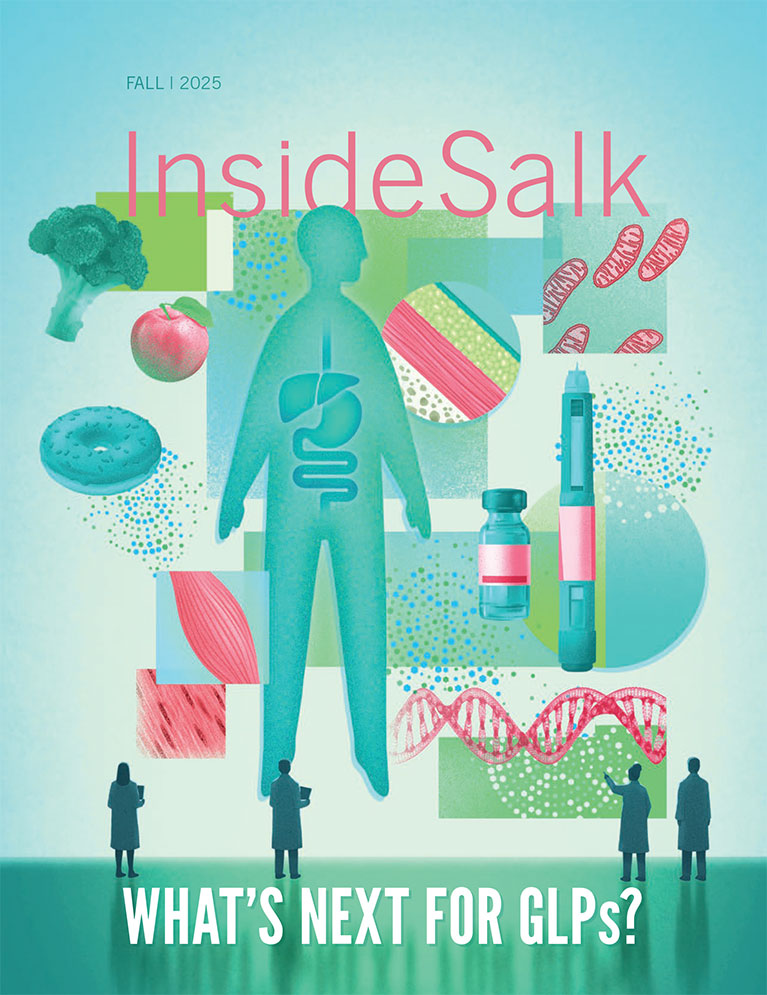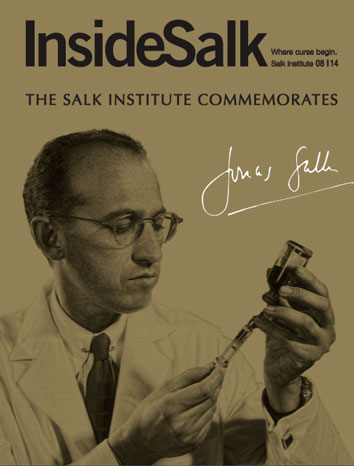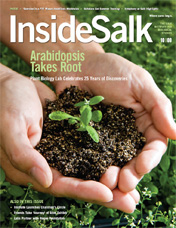OBSERVATIONS Kay Tye Breaking down the brain
Kay Tye, the newest addition to Salk’s faculty, is a burst of energy who can chat about everything from the mysteries of the brain to the intricacies of a breakdance move. You might find her brushing off sand from her wetsuit after surfing near a pod of dolphins, or having an “intellectual jam session” with one of her lab members in her study overlooking the Pacific.
Before arriving at Salk, Tye was an associate professor at the Massachusetts Institute of Technology (MIT), where she also received her bachelor’s degree before studying at UC San Francisco and Stanford University. The recipient of numerous awards and recognitions—including the NIH Director’s Pioneer Award, Society for Neuroscience’s Young Investigator Award and MIT Technology Review’s list of 35 Innovators Under 35—Tye is investigating the neural circuit basis of social and emotional processing. Her research will help us better understand why we are the way we are and what drives social interactions, which may have implications for anxiety disorders, addiction and depression.
Inside Salk sat down with Tye to discuss her roundabout journey to science, her passion for mentorship, and her love of life outside the lab.
Tell us about your path to becoming a globally renowned neuroscientist. How did you decide on a life of research?
My parents were scientists and professors at Cornell University. Ithaca is lovely but remote, so I was interested in going to college anywhere else. I chose MIT, one of the few schools I got into that my parents deemed acceptable over Cornell.
However, I had some discouraging training experiences as an undergraduate, so I took a year off after school and backpacked around Australia. There, I lived on a remote farm that was 500 kilometers from the nearest paved road. After that, I was a yoga instructor, which I really enjoyed doing, but I had a moment when I realized that I could give the same class over and over again and no one could tell the difference. I wanted to feel like what I’d done in the past mattered, and that what I’m doing matters.
Science is incredible in that way: Not only do you build upon what you’ve done in the past, but everyone else can build on your past work as well, so you feel the impact of your work as it influences others.
I decided to go to graduate school at the University of California, San Francisco. I had a really tough time in my first year of graduate school and was on the verge of dropping out. That’s when my PhD mentor, Patricia Janak, along with my mom, helped me to not give up.
It’s hard to imagine that you were on the verge of dropping out of graduate school, given how successful you are today. How did you hit your stride?
It was a big adjustment to go back into the academic atmosphere after living in a tent on the beach for months. I felt like I wasn’t good enough. Now that I’m where I am, it’s really obvious to me that this is the path I was supposed to take, but there were so many times when I almost didn’t continue and worried I couldn’t keep up with everyone else. I had done three rotations, but the lab I liked didn’t choose me, and I was devastated. I did an extra rotation and connected with Patricia Janak, who turned me from a puddle of tears into a functioning, competent scientist. She believed in me and helped me unearth my strengths. At the same time, my mom was like, “You need to do a little less whining and a little more working.” It was that combination of tough love from my mom and patient nurturing from my PhD adviser that helped me grow into a professional. By the second year of grad school, I was completely convinced that science was my calling. It was a dramatic turnaround.
That is a great example of how important mentorship is. Is your mom a big inspiration?
Some of the challenges that I faced as an undergrad were very specific to my gender, but I was fortunate to benefit from very strong female role models throughout my life. My mom is my biggest role model in that regard. She was glad that her first name—Bik, a Chinese name—is ambiguous here. She once told me that people were surprised when she showed up to meetings, because they’d thought she was a man. She felt that helped her career. When I was growing up, she’d tell me I didn’t have to choose between a family and a career, and that women can do anything men can do.
Many of my female colleagues have dealt with balancing family and career in different ways. I’ve always been proud to be a very committed parent—right now, of a six-year-old and a three-year-old. My daughter was probably the youngest person to ever attend a Gordon Research Conference; I took her when she was 6 weeks old. And of course, none of this would have been possible without having a wonderful and supportive partner, my husband, Jim Wagner.
Now that you are leading a lab at Salk, how do you approach mentorship?
The mentor-mentee relationship is sacred, and academia is one of the last professions that uses a mentor-mentee model.
Over time, I learned that whoever asks the most questions learns the fastest, and you can’t be afraid of looking stupid when you’re in pursuit of knowledge. If you worry about that, you’re just going to impede your learning. I try to convey that as a mentor. Another thing I learned as a manager is that you should hire people that you are excited about working with.
The most important thing about being a good mentor is constantly applying effort to becoming a better mentor. Every mentee is different, and every mentee’s needs will change as they develop. Nobody’s perfect, but if you really care about people’s well-being and their future, that’s your guide star as a mentor. Are you going to be perfect? There’s no such thing. It’s like how people are nervous about being good parents: There will be some mistakes, but you love your kids and you’ll figure it out together.
What big questions do you hope to explore at Salk?
One big-picture question I’m exploring is, how do we process emotional value—or valence—and change that? For example, you hear a song at a party, and some people get really excited, while other people hate that song. I want to understand how you assign valence to something you’ve never seen before and how you change the way you assign it when you’ve seen it many, many times but in different contexts.
Another big question I’m really interested in is how the brain represents social homeostasis—that is, how do our brains determine if we have the right amount (quality, quantity, nature) of social contact? How do we sense when we need more “me” time versus feel lonely? What controls the motivation to seek social contact?
Related to this, I’m also interested in how groups of individuals know their place in a hierarchy. Humans are capable of creating and maintaining many different types of social hierarchies and social structures. For example, you come into a new sports team, and it doesn’t take that long to figure out who’s the leader, right? And the leader might not be the person assigned that role; it might actually be someone else. But you pick up those cues and figure it out.
Social processing encompasses a huge part of our brain. We don’t really even know how much yet or what the complete circuits are. We have some nodes that are probably involved, but we really have no good handle on how the brain performs many of its everyday social functions, like integrating rank information with gesture recognition to determine if behavior is “socially appropriate.”
How does exploring the neural circuits of social processes build on your previous work on addiction and reward circuitry?
Our previous work focused primarily on emotional processing and how we assign positive or negative valence to things in the world around us. We have also published on social reward and motivation to seek social contact when isolated.
In modern society, a lot of our happiness and pain comes from social stimuli. It might be an email. It might be someone’s offhand comment. It might be road rage. It might be workplace politics or relationships with our family. Understanding how we process straightforward stimuli—hunger, for example—is important, because if we don’t know that, then a complex problem like how to interpret that nuanced offhand comment would be impossible.
There are a lot of different components that are feeding into it: past experiences and associations with this individual; identification of your relative rank to this individual’s relative rank; extrapolating what the potential consequences of this would be. It’s interesting that we care so much about an interaction that has almost no bearing on our survival. Why do we let something that is almost certainly not going to kill us upset us so much? These are some of the questions we want to explore.
Speaking of social interactions, you mentioned you were involved in the breakdancing scene. Tell us more about that.
I used to be really into breakdancing. I got serious about it in grad school, entered competitions and did shows for the Warriors. Windmills—where you roll along your shoulders—was the hardest move I mastered. That wooden boom box on my shelf is a prize for being the best “B-girl” in a breakdancing battle. It definitely was a huge part of my life, but that was a long time ago. I haven’t been a part of the competitive scene since I had kids.
What hobbies do you have now?
I’ve recently taken up surfing since moving to San Diego. I’m pretty obsessed with it right now. It makes me feel so alive. I go a few times a week with lab members just right here by Salk. We’ve seen dolphins and seals stealing our waves. I still do yoga a couple times a week, and I’ve started horseback riding again. I also love running in the canyons by my house. In general, I need a lot of activity. It’s good for your brain to change states and stay flexible. And of course, everybody knows that exercise promotes neurogenesis.
It sounds like San Diego is agreeing with you! Of all the places to build your lab, why did you choose Salk to launch this next phase of your career?
Well, just look around! From the first time I came here, I thought to myself, “Why don’t I live here? Why can’t this become my reality?” It is just so beautiful. It is hard not to feel inspired walking into work every day. I totally love San Diego, and have become a San Diego evangelist, trying to convince everyone I love to move here.
But in all seriousness, I found myself craving freedom, and what’s the point of “success” if I don’t have freedom? Giving good scientists freedom to pursue their scientific interests and go in whatever direction that they want—that is a great model. That’s what drew me to Salk.
While there are things I will miss about being at a degree-granting institution, everything takes time…and I found myself drowning in administrative, departmental, teaching, advising and other types of work that pulled me away from the actual scientific research. That’s the part I love the most, and Salk’s model of clearing your schedule to allow you to focus on your research is refreshing.
Support a legacy where cures begin.
Featured Stories
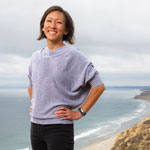 Kay Tye – Breaking down the brainKay Tye, the newest addition to Salk’s faculty, is a burst of energy who can chat about everything from the mysteries of the brain to the intricacies of a breakdance move. In this Q&A, she discusses her roundabout journey to science, her passion for mentorship and her love of life outside the lab.
Kay Tye – Breaking down the brainKay Tye, the newest addition to Salk’s faculty, is a burst of energy who can chat about everything from the mysteries of the brain to the intricacies of a breakdance move. In this Q&A, she discusses her roundabout journey to science, her passion for mentorship and her love of life outside the lab. How to stop a killerPancreatic cancer is one of the most difficult cancers to detect and treat, in part because of an impenetrable "shield" that forms around the tumor. Salk scientists, many of whom have a personal connection to cancer, are leading the charge in new approaches to tackle this deadly disease.
How to stop a killerPancreatic cancer is one of the most difficult cancers to detect and treat, in part because of an impenetrable "shield" that forms around the tumor. Salk scientists, many of whom have a personal connection to cancer, are leading the charge in new approaches to tackle this deadly disease.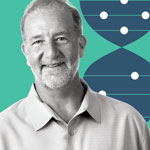 Travis Berggren – Working at the intersection of biology and technologySenior Staff Scientist Travis Berggren shares his path to Salk and his perspective on how advances in technology facilitate world-changing discoveries in genetics, neuroscience, cancer, immunology, plant biology and other areas.
Travis Berggren – Working at the intersection of biology and technologySenior Staff Scientist Travis Berggren shares his path to Salk and his perspective on how advances in technology facilitate world-changing discoveries in genetics, neuroscience, cancer, immunology, plant biology and other areas.
